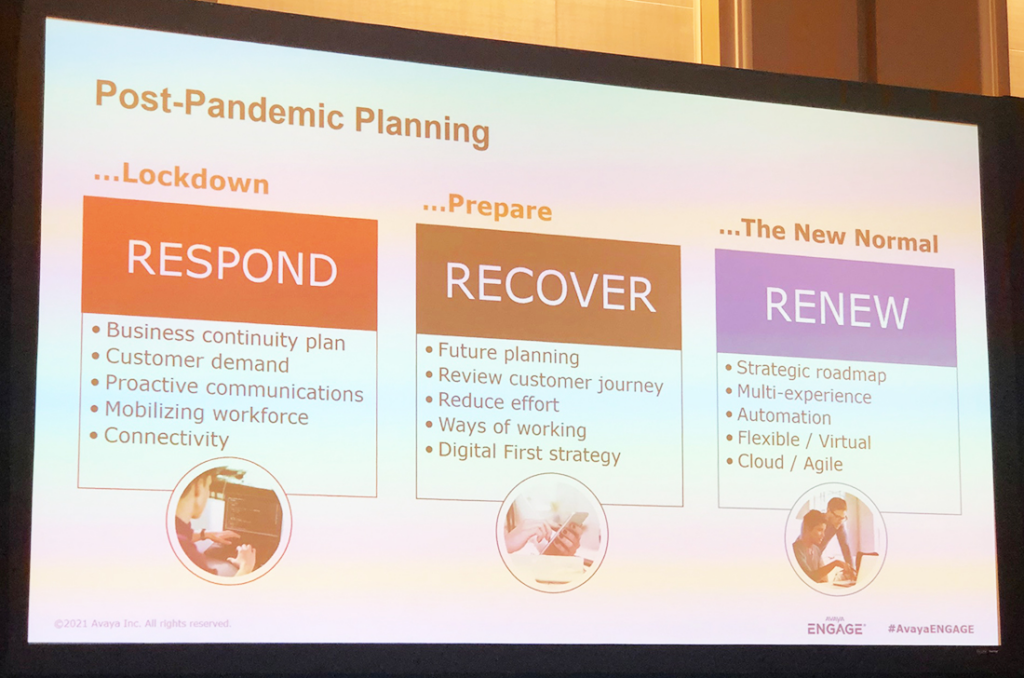To say that the COVID pandemic was a challenge for organizations around the world is certainly an understatement. In March 2020, IT professionals had to manage the sudden shift to remote work platforms and address unprecedented demand for digital services and support.
Nearly two years later, the COVID omicron variant is continuing to confound business continuity planning, but at least the sense of crisis is past, according to Richard English, managing director, Avaya Corporate Consulting.
“The COVID pandemic forced businesses to change overnight,” said English at an Avaya ENGAGE 2021 session, “Business Continuity: A Post-Crisis Conversation.” For many organizations, the biggest problem in spring 2020 was managing a dramatically increased flow of inquiries with a reduced workforce. Customers faced in long wait times when reaching out to contact centers, and agents had to scramble to solve more complex issues, let alone provide a satisfactory customer experience.
“Organizations realized that business continuity involves people and processes as well as technology,” said English. “When there is staffing shortage, you need to be able to leverage technologies like artificial intelligence (AI) and implement processes like digital deflection. Customer segmentation tools can also help managers handle a heavy workload in contact centers.”

Recovery and renewal
After responding to the pandemic in 2020, organizations are now moving through the recovery and renewal phases, reviewing the needs of their employees and customers and preparing flexible roadmaps for the new normal, English said.
In the coming months, IT professionals should identify gaps in the delivery of services and support to customers and employees. “Where are the friction points, such as dropped or abandoned calls,” he said. “If you are still using IVR call flows from years ago, those processes need to be revisited and rewritten. And you need to leverage those call flows so customers can use self-service to get answers to easy questions.”
Enterprises should also review their remote work policies and procedures. “You need to be sure an agent working from home is the right person to handle a call, such as meeting PCI [payment card industry] compliance standards in the financial sector.”
Now is also a good time to look at remote workers’ communication and collaboration tools. “You need to understand if they have a safe and secure working environment with visibility into scheduling and hours,” he said. “You should also look at their setting to be sure they present a professional image, without a crying baby or barking dog in the background.”
As part of that assessment of people, processes, and technology, contact center managers need to determine if agents are most effective working from home or if they need to come back to an office setting. “Agents who are self-disciplined typically have the ability to work well at home, but others may do better with direct supervision, English said.
What lies ahead?
One of the biggest post-crisis challenges for IT professionals is trying to project the organization’s future requirements. While some analysts project the number of remote workers will continue increasing, others see a gradual return to the office, depending on the individual’s job function.
Regardless of the post-pandemic scenario, IT professionals should understand that remote workers will continue to be an important part of the employment picture. In that regard, cloud-based platforms can provide a foundation for providing a consistent set of tools and experiences for employees, as well as delivering an appealing and engaging customer experience, he said.
“Now is the perfect time to look at your IT communications infrastructure in terms of flexibility, as well as resiliency, security, and scale,” English said. “But you need to look at your people and processes as well. If you don’t have the right people, all the digital-first capabilities won’t reach their full potential. So, reset your operating model, and move your strategic planning forward with a focus on people as well as technology.”
